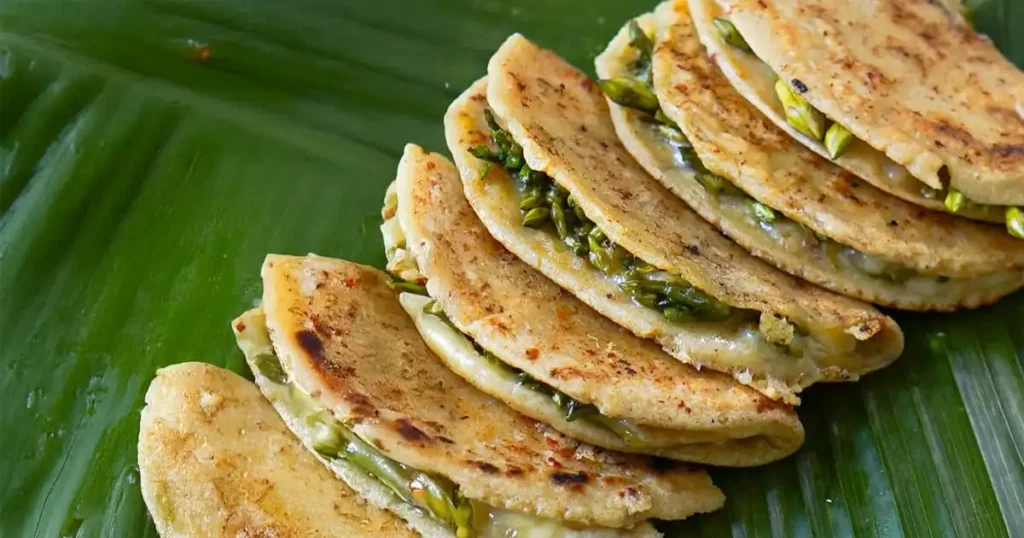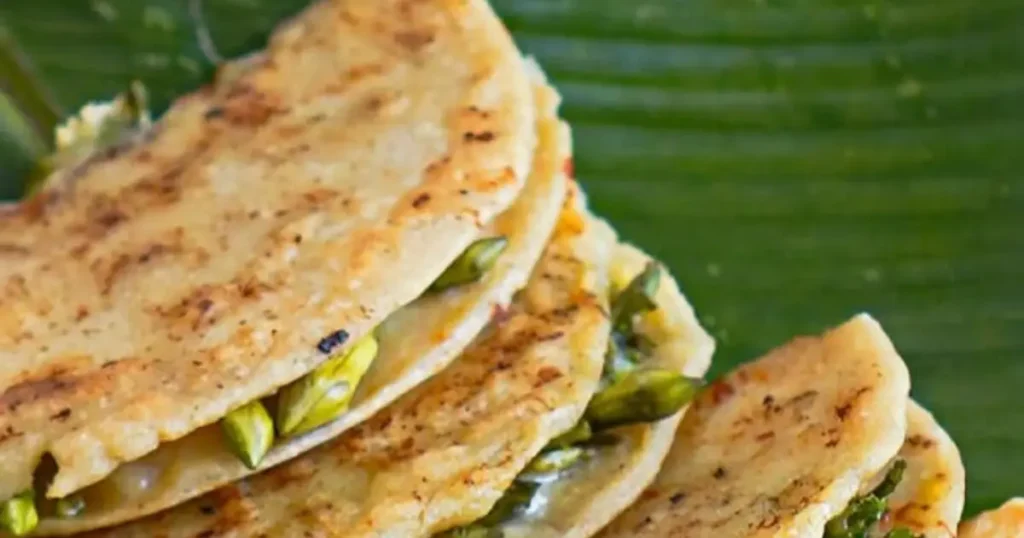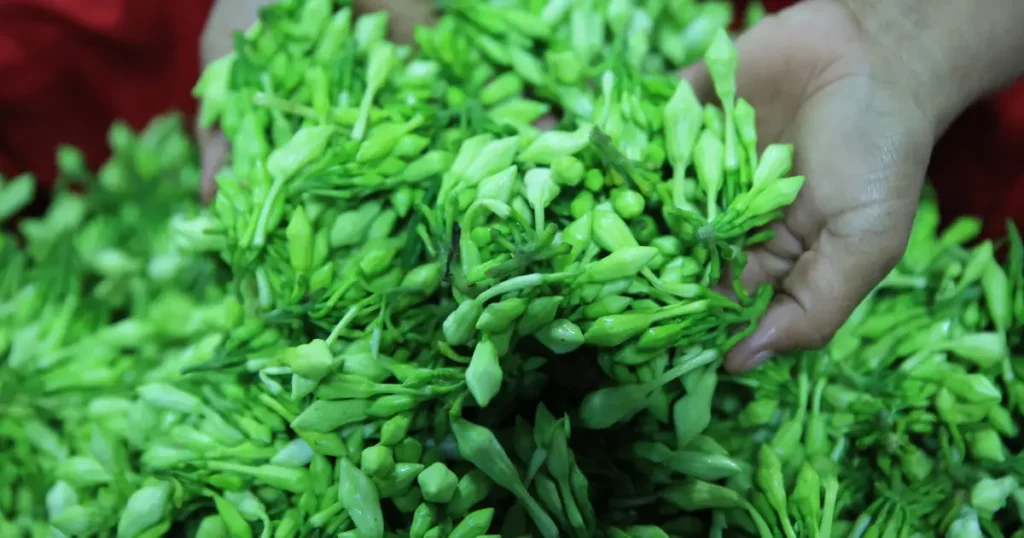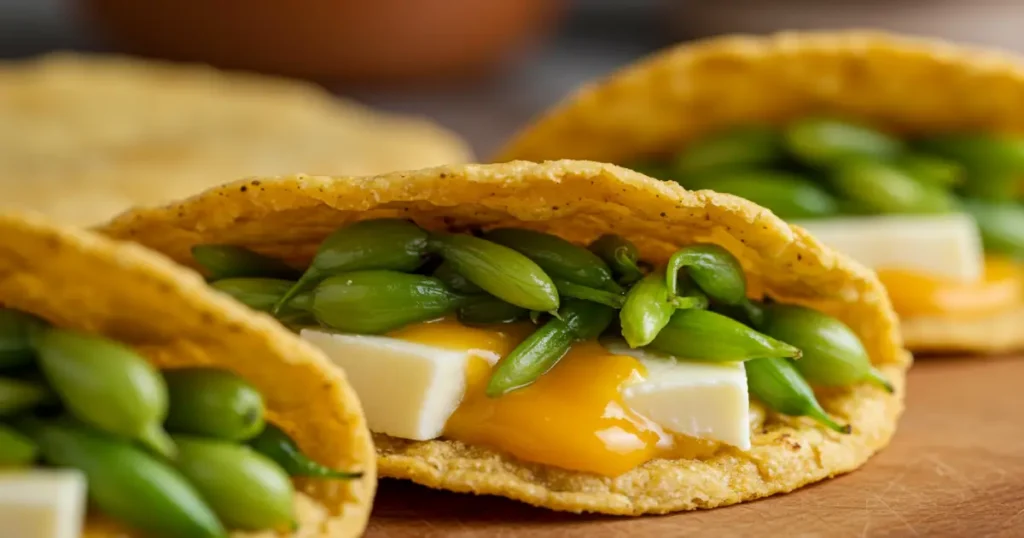Tortillas con Loroco y Queso: Guatemala's Delicious Stuffed Dish

In the vibrant culinary landscape of Guatemala, where ancient Mayan traditions meet colonial influences, there exists a beloved specialty that tantalizes the taste buds with its unique combination of earthy, floral notes and savory, melted cheese: the tortillas con loroco y queso.
These aren't your everyday thin corn tortillas; rather, they are thick, handmade corn masa patties, generously stuffed with the prized loroco flower and local Guatemalan cheese, then cooked to golden perfection on a hot comal.

Often bearing a strong resemblance to the Salvadoran pupusa, this dish holds a special place in Guatemalan hearts and stomachs, offering a truly authentic taste of the region's rich biodiversity and culinary heritage.
This article will guide you through the aromatic world of tortillas con loroco y queso, exploring the significance of its star ingredients, the art of its preparation, its cultural importance, and where you might savor this delightful treat in the Land of Eternal Spring. Whether you're a seasoned traveler in Central America or a curious foodie exploring new flavors, Guatemala's tortillas con loroco y queso are a culinary experience not to be missed.
Loroco: The Aromatic Green Jewel of Guatemalan Cuisine
The magic of tortillas con loroco y queso begins with its most distinctive ingredient: loroco. This humble green flower bud is a culinary treasure throughout Central America, and particularly cherished in Guatemala.
What is Loroco?

Loroco, scientifically known as Fernaldia pandurata, is an edible flowering vine native to Central America. The unopened flower buds are the part used in cooking. These buds are slender, green, and typically harvested when they are young and tender. In Guatemala, loroco is a familiar sight in local markets, often sold in bunches, and is a staple in many traditional dishes. Its use predates colonial times, with indigenous populations having long recognized its culinary value.
A Unique Flavor Profile
The flavor of loroco is what makes it so special and sought after. It's complex and quite distinct, often described as:
- Earthy and Pungent: It has a deep, savory character.
- Slightly Grassy or Vegetal: With hints reminiscent of asparagus, artichoke, or even green beans.
- Aromatic and Floral (in a savory way): While a flower, its aroma contributes to its savory profile rather than a sweet one.
- Nutty Undertones: Some palates detect a subtle nuttiness.
This unique taste profile allows loroco to stand out, yet beautifully complement other ingredients, especially the mildness of cheese and the earthiness of corn masa.
Seasonality and Harvesting in Guatemala
Loroco is a seasonal delight, with its peak availability in Guatemala typically spanning from late spring to early fall (around May to October). During these months, fresh loroco is abundant in markets. The buds are carefully hand-picked from the climbing vines. Outside of its fresh season, loroco can also be found preserved – pickled in vinegar (en vinagre) or frozen – allowing Guatemalans to enjoy its distinct flavor year-round, though fresh is always preferred for dishes like tortillas con loroco y queso.
Cultural Significance and Culinary Uses
In Guatemala, loroco is more than just an ingredient; it’s a taste of tradition and home for many. It’s woven into the fabric of everyday cooking and special meals. Beyond being the star in tortillas con loroco y queso, it is also used:

- Mixed with scrambled eggs (huevos con loroco)
- In rice dishes (arroz con loroco)
- As a topping for pizzas (a more modern application)
- In tamales
- In creamy sauces for chicken or pork
- Simply steamed or sautéed as a side dish
Its presence in a meal often evokes a sense of nostalgia and cultural pride.
Queso Guatemalteco: The Perfect Melty Counterpart
The "queso" in tortillas con loroco y queso is just as crucial as the loroco. Guatemalan cheeses offer a range of flavors and textures, but specific types are favored for this dish to achieve that irresistible, gooey, melted center.
An Overview of Guatemalan Cheeses
Guatemala boasts a variety of local cheeses, many of which are fresh, artisanal, and unpasteurized, though commercial, pasteurized versions are also widely available. Some common types include:
- Queso Fresco: A fresh, white, slightly salty, and crumbly cheese.
- Queso Seco: A drier, saltier, aged version of queso fresco, often grated.
- Queso de Capas: A layered, stringy cheese, somewhat similar to mozzarella or Oaxaca cheese.
- Quesillo: This is the hero for stuffed tortillas. It’s a soft, mild, white cheese that melts exceptionally well, known for its stringiness. It is very similar to Salvadoran quesillo and Mexican Oaxaca cheese.
- Queso Crema: A rich, spreadable cream cheese.
Ideal Cheeses for Tortillas con Loroco y Queso
For the perfect melt and mild flavor that allows the loroco to shine, the most commonly used and recommended cheese is:
- Quesillo: This is the star cheese for these tortillas (and pupusas). Its superior melting quality creates the luscious, stringy cheese pulls that are so desirable. Its mild, slightly tangy flavor complements the pungent loroco without overpowering it. Recipes almost universally call for quesillo or a similar melting cheese.
- Queso de Capas: If quesillo isn't readily available, a good quality queso de capas can also work well due to its similar stringy and meltable nature.
- A Blend (Occasionally): Some cooks might use a blend, perhaps incorporating a bit of queso fresco for a slightly different flavor dimension, but the primary component for melting will usually be quesillo. Commercial "queso para pupusas" is also available, which is typically a blend formulated for optimal melting.
The key is to use a cheese that becomes soft, gooey, and slightly elastic when heated, creating a delightful contrast in texture to the corn masa.
The Art of Making Tortillas con Loroco y Queso: A Step-by-Step Guide
Making tortillas con loroco y queso at home is a rewarding culinary adventure. While it takes a bit of practice to master the stuffing and shaping, the process is straightforward. These are essentially Guatemalan pupusas.
Ingredients:
- For the Masa:
- 2 cups corn masa harina (Maseca or a similar brand)
- 1 ½ to 2 cups warm water (or as needed)
- ½ teaspoon salt (optional)
- For the Filling:
- 1 to 1.5 cups fresh loroco buds, cleaned and finely chopped
- 1.5 to 2 cups quesillo (or other suitable melting cheese), grated or finely chopped/shredded
- Salt to taste (be mindful if your cheese is already salty)
Masa Preparation:
- Combine Ingredients: In a large bowl, combine the masa harina and salt (if using).
- Add Water Gradually: Slowly add the warm water, mixing with your hands until a soft, pliable, and moist dough forms. It should not be too sticky or too dry. The consistency should be similar to play-dough. If it's too dry, add a little more water; if too sticky, add a little more masa harina.
- Knead Briefly: Knead the dough for a few minutes until it's smooth. Cover with a damp cloth and let it rest for 10-15 minutes. This allows the masa harina to fully hydrate.
Preparing the Filling:
- Prepare Loroco: Ensure the loroco buds are clean. Remove any tough stems. Finely chop the loroco. Some people prefer to blanch the loroco briefly, but for stuffing, finely chopping it raw is common.
- Prepare Cheese: Grate the quesillo or chop it into very small pieces.
- Combine Filling: In a bowl, mix the chopped loroco and the quesillo. Add a pinch of salt if needed, depending on the saltiness of your cheese. Mix well until evenly combined.
Step-by-Step Assembly and Cooking:
This process is identical to making pupusas:
- Portion the Masa: Divide the rested masa into 8-10 equal-sized balls (about the size of a golf ball or slightly larger).
- Shape the Masa Cup: Take one ball of masa. Using your thumbs, press into the center of the ball to create an indentation, then continue to work your fingers around the edges to form a small, thick-walled cup or disc with a hollow center. Some people clap the masa ball into a flat disc first, then create a slight indent.
- Add the Filling: Place a generous spoonful (about 1-2 tablespoons) of the loroco and cheese mixture into the masa cup. Don't overfill, as it will make sealing difficult.
- Seal the Tortilla: Carefully bring the edges of the masa cup together, enclosing the filling completely. Pinch the edges to seal tightly. Gently pat and shape the filled dough back into a ball, ensuring the filling is well encased.
- Pat into a Disc: Now, carefully pat the filled ball of dough between your slightly moistened or oiled palms to form a flat, round disc, about ¼ to ½ inch thick and 4-5 inches in diameter. Try to make them as even as possible. If small cracks appear, pinch them closed. This step takes practice!
- Cook on the Comal: Heat a comal, cast-iron skillet, or a non-stick griddle over medium heat. It should be hot but not smoking.
- Place the stuffed tortillas on the hot comal.
- Cook for about 3-5 minutes per side, or until they are nicely golden brown and slightly blistered in spots. The cheese inside should be melted and gooey. You may see some cheese ooze out, which is perfectly fine and delicious.
- Keep Warm: As the tortillas con loroco y queso are cooked, you can keep them warm by wrapping them in a clean kitchen towel or placing them in a tortilla warmer.
Tips for Success:
- Masa Consistency: Getting the masa right is key. If it's too dry, it will crack. If too wet, it will be sticky and hard to handle.
- Don't Overstuff: While a generous filling is desired, overstuffing can lead to blowouts during cooking.
- Moisten Hands: Keep a small bowl of water (sometimes with a little oil mixed in) nearby to moisten your hands while shaping. This prevents the masa from sticking and helps create a smooth surface.
- Proper Comal Temperature: If the comal is too hot, the outside will burn before the inside is cooked and the cheese melted. If too cool, they will take too long and can dry out.
Serving and Accompaniments: A Guatemalan Tradition
Tortillas con loroco y queso are rarely served alone. They are traditionally accompanied by two key condiments that elevate the dish:
- Salsa de Tomate (Tomato Sauce): This is typically a simple, cooked tomato sauce, often not spicy, though some versions might have a mild kick. It’s usually thinner than a pasta sauce and is meant to be spooned over the warm tortillas.
- To make a basic version: Boil tomatoes with a piece of onion and garlic, then blend. Some recipes might include a bit of oregano or other mild spices. Cook briefly.
- Curtido (Pickled Cabbage Slaw): This provides a tangy, crunchy contrast to the rich, cheesy tortillas. The Guatemalan curtido is very similar to the Salvadoran version.
- To make a basic version: Finely shred cabbage and carrots. Add thinly sliced onion. Dress with vinegar (apple cider or white), a pinch of salt, and sometimes a bit of oregano. Let it sit for at least 30 minutes, or even better, a few hours or overnight in the refrigerator, for the flavors to meld.
How They Are Eaten: Tortillas con loroco y queso are typically eaten with the hands. Diners spoon some salsa de tomate over the top and add a generous helping of curtido. They can be enjoyed as a hearty snack, a light lunch, or a main meal.
Drinks: Common beverages to accompany this dish include:
- Traditional Guatemalan frescos (fresh fruit drinks) like rosa de jamaica (hibiscus) or tamarindo.
- Guatemalan coffee.
- Horchata (a sweet, rice-based milky drink).
Regional Variations and Modern Interpretations
While the basic recipe for tortillas con loroco y queso is fairly consistent, some nuances might exist:
- Regional Preferences: Certain regions in Guatemala, particularly those where loroco grows abundantly (like eastern Guatemala or areas with fertile volcanic soil), might have a stronger tradition of making these. The specific local quesillo or melting cheese used can also introduce subtle regional flavor differences.
- Family Recipes: As with many traditional dishes, recipes can vary slightly from family to family, with minor adjustments to seasoning or the masa-to-filling ratio.
- Terminology: In many parts of Guatemala, especially in areas with Salvadoran influence or in establishments run by Salvadorans, these will simply be called "pupusas de loroco con queso." However, the term "tortilla con loroco y queso" is also used and understood to mean essentially the same delightful, stuffed corn patty.
- Modern Twists: Contemporary Guatemalan chefs and restaurants might experiment with adding other ingredients to the filling, such as finely diced jalapeños for a spicy kick, or using different types of artisanal cheeses. However, the classic loroco and quesillo combination remains the most beloved.
Cultural Significance and Where to Find Them in Guatemala
Tortillas con loroco y queso are more than just food; they represent a cherished culinary tradition and a taste of home for many Guatemalans.
- A Comfort Food Staple: They are a popular comfort food, enjoyed by people of all ages and social classes. The combination of warm corn masa, melted cheese, and the unique flavor of loroco is deeply satisfying.
- Markets and Street Food: These tortillas are commonly found in local markets, at street food stalls (puestos), and in comedores (small, family-run eateries). Often, you can see them being made fresh to order.
- Pupuserías and Specialized Tortillerías: Many towns and cities will have pupuserías (eateries specializing in pupusas, which would include the loroco and cheese variety) or specialized tortillerías that make these thicker, stuffed tortillas.
- Festivals and Celebrations: While an everyday food, they can also feature during local festivals and gatherings.
The Pupusa Connection: It's important to acknowledge the strong connection to Salvadoran pupusas. El Salvador is internationally renowned for its pupusas, and loroco with cheese is one of the classic fillings there as well. The two countries share a culinary heritage, and this dish is a prime example. In Guatemala, while some may make subtle distinctions, the preparation and enjoyment are largely identical. The pride in this dish is shared across borders.
Why Tortillas con Loroco y Queso Are a Must-Try Guatemalan Experience

For anyone visiting Guatemala or wishing to explore its authentic flavors, tortillas con loroco y queso offer a unique and memorable gastronomic experience:
- Unique Flavor Combination: The pungent, floral notes of loroco combined with the savory, melted cheese and earthy corn masa is a flavor profile unlike any other.
- Showcase of Local Ingredients: This dish beautifully highlights fresh, local, and seasonal ingredients like loroco and artisanal Guatemalan cheeses.
- Heartwarming and Satisfying: They are the epitome of comfort food – warm, cheesy, and incredibly filling.
- Cultural Immersion: Enjoying these tortillas, especially from a local vendor or in a traditional eatery, offers a genuine taste of Guatemalan culture and hospitality.
A Floral Embrace in Every Bite
The tortillas con loroco y queso of Guatemala are a testament to the country's rich agricultural bounty and its people's ingenuity in creating delicious, soulful food from humble ingredients. Each bite offers a warm, floral embrace, a cheesy delight, and a connection to the vibrant culinary traditions of Central America. Whether you find them in a bustling market, a quiet family eatery, or decide to embark on the rewarding journey of making them in your own kitchen, these stuffed corn tortillas are a true Guatemalan treasure waiting to be savored.

Leave a Reply